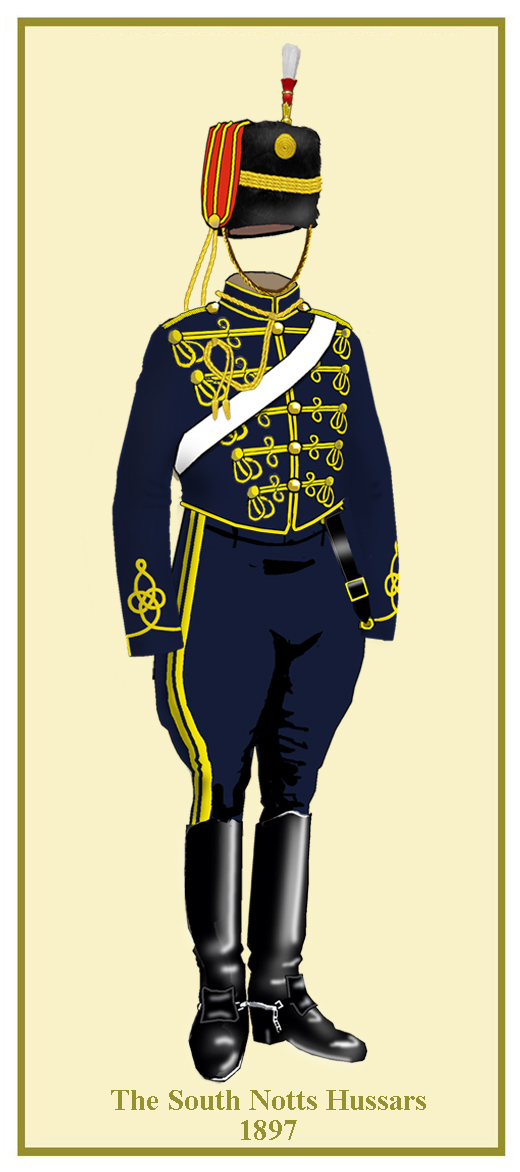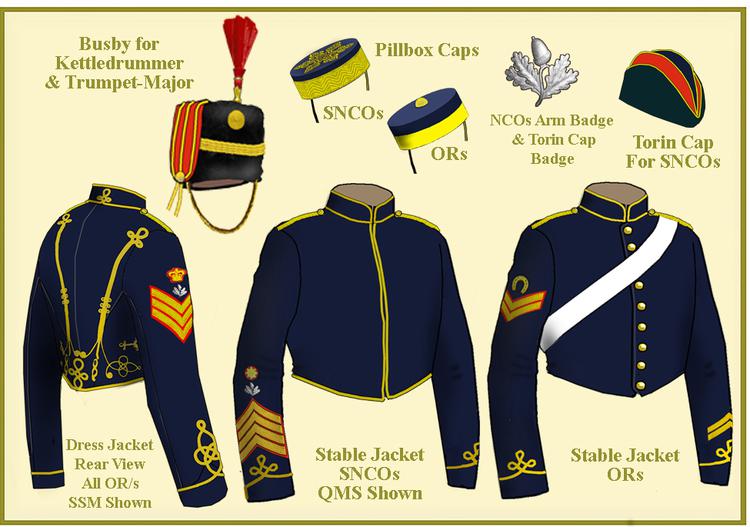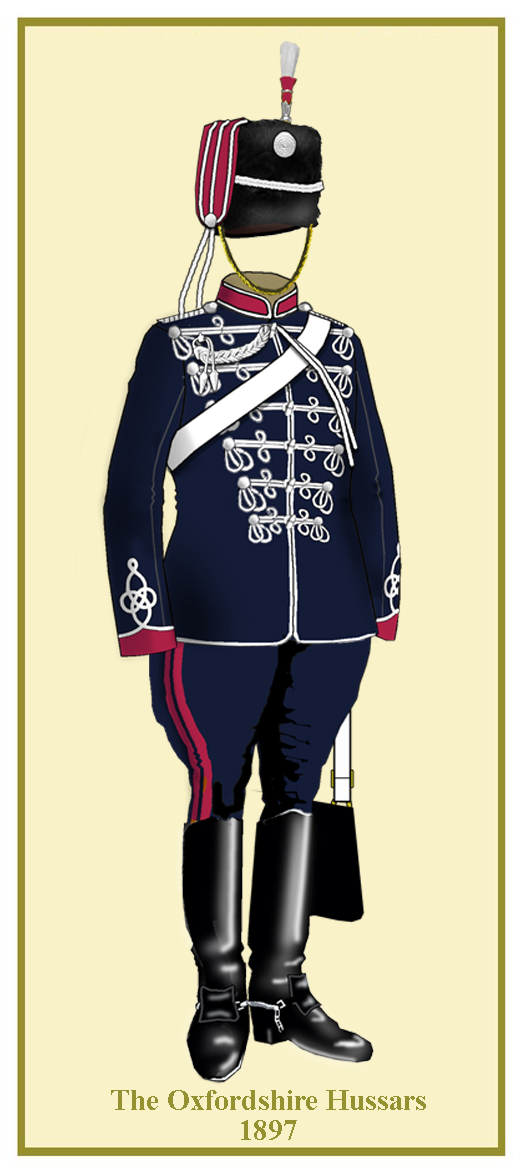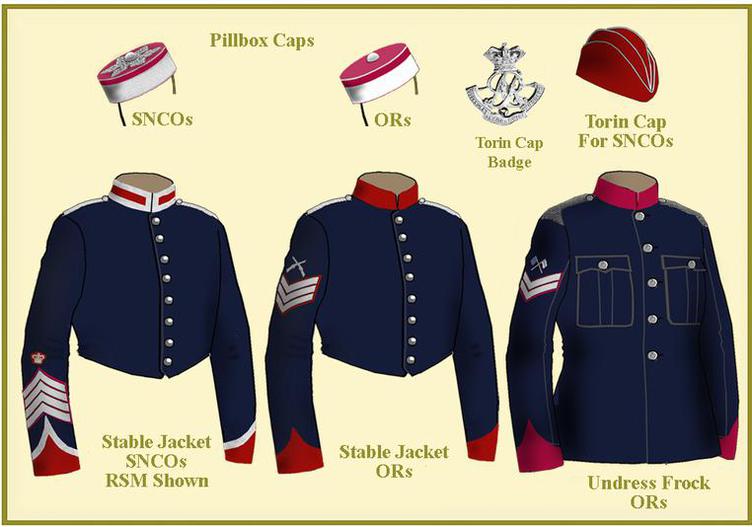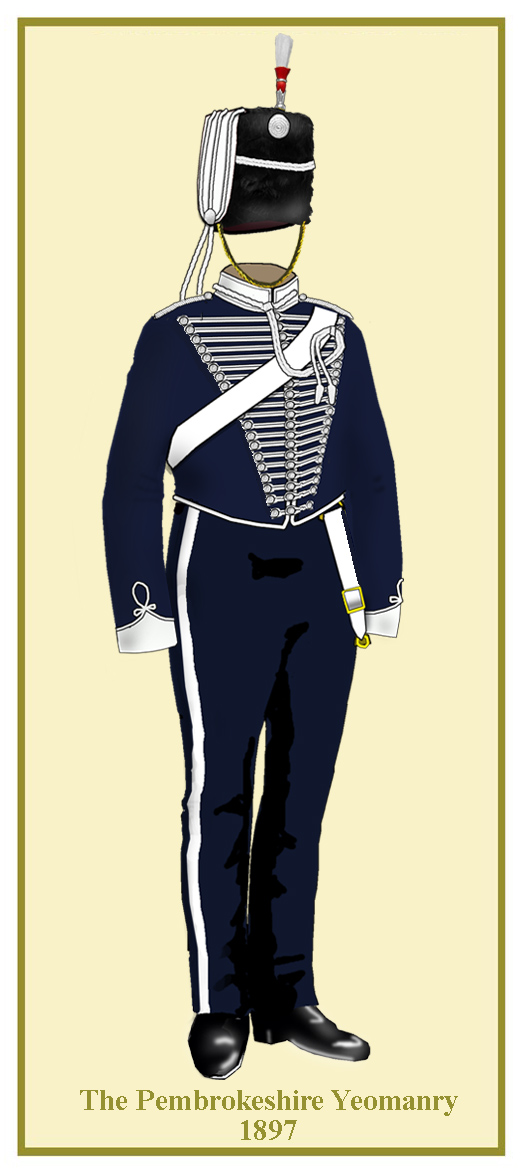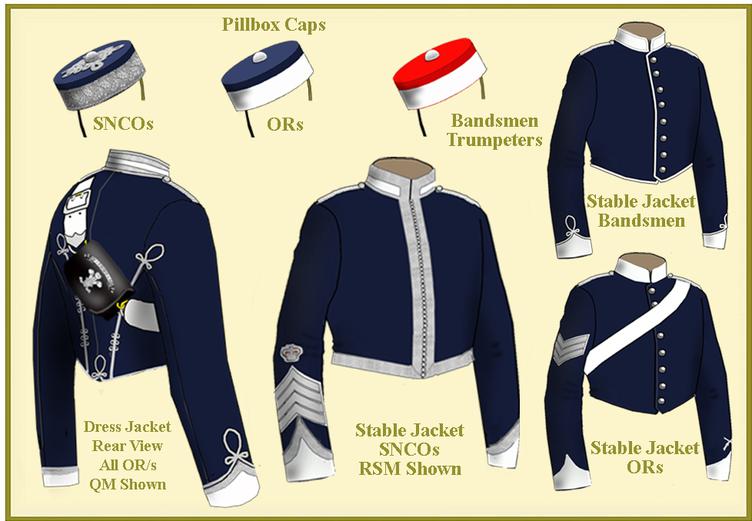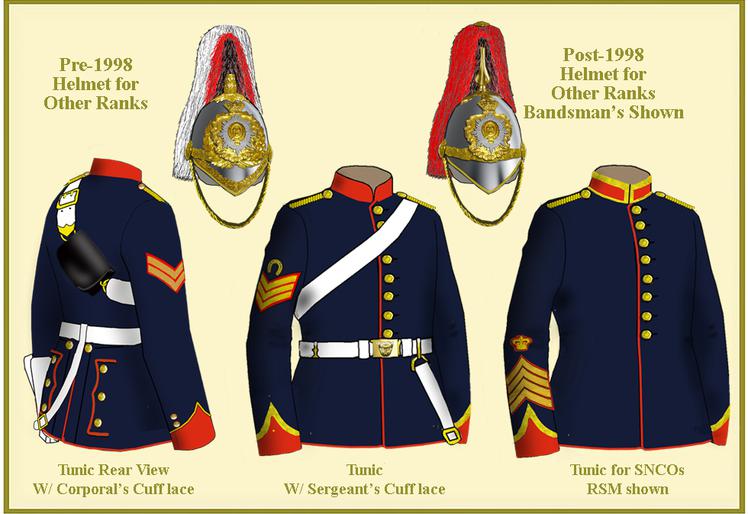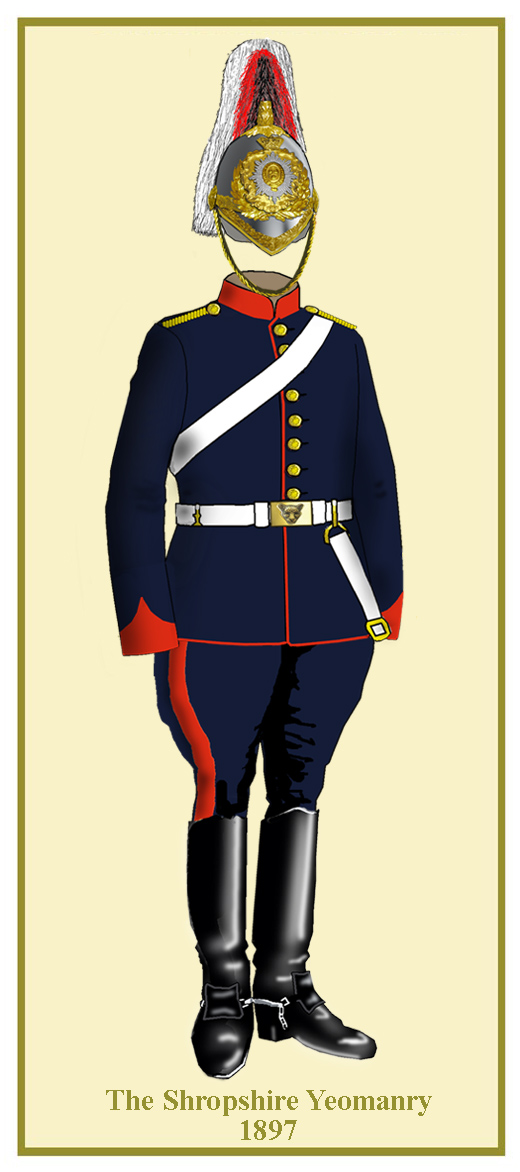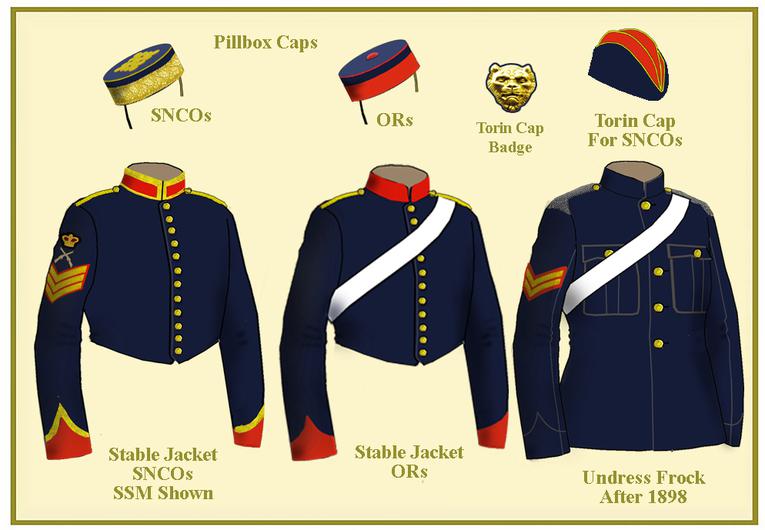The South Nottinghamshire Hussars Yeomanry
Ranked No. 15 in Yeomanry Order of preference
The history of the Nottinghamshire Yeomanry until 1828 has been told under that of the Sherwood Rangers. After the split between north and south the regiment from the latter part took the logical name of South Nottinghamshire Yeomanry. However, their role for the following twenty years mirrored that of their sister regiment in quelling industrial and social unrest from Reform Bill Rioters to Chartists. By 1846 there were five troops and after 1850 with the decline of civil disorder, their role became that of reserve cavalry and in 1870 became Hussars. There were four squadrons in 1898.
Formed 12th Coy of 3rd Bn Imperial Yeomanry in 1900
UNIFORMS OF THE BRITISH YEOMANRY REGIMENTS 1895-1900
PART 7
Uniforms
The description of the uniforms for the Nottinghamshire corps up until 1828 has been given under the Sherwood Rangers. While the northern corps chose their unique green uniform the South Nottinghamshire settled on a more traditional light dragoon uniform of dark blue with scarlet collar, cuffs and plastron. The trousers were light blue with broad scarlet stripes. All lace was gold and officers had boxed epaulettes with fringes. The black bell topped shako had a white and red plume with a star plate surmounted by a crown. In 1840, in line with contemporary fashion they adopted the 1840 pattern plain dark blue jackets with scarlet collar and pointed cuffs, dark blue trousers with double scarlet stripes and a plainer shako with a garter star plate. The plume became black. The uniform changed in 1846 to a more Prussian look with short dark blue jacket, five loops of gold (yellow for the men) frogging with drops and caps across the front. The facings were the same as the jacket colour. The trousers now had double yellow piping and shako remained the same as before. This uniform, apart from the headdress, would remain essentially the same until the end of the century. In 1847 a French style tall tapered scarlet shako was adopted which had a large cockade with loop and button on the front. At the time, this headdress was compared to that of the Chasseurs d’Afrique. In 1861 a lower shako was taken into use, this was of dark blue cloth with a black plume and normal cap lines. At the same time, the braiding on the jacket was changed to match that of regular hussars with Austrian knots on the cuffs. Finally, in 1866 the hussar busby was adopted with white over red plume and yellow cap lines. The barreled sash, which had been worn by other ranks since about 1847 was discontinued in 1867 and pantaloons and knee boots were introduced in 1891. It is not known when the 1888 pattern busby was adopted but it appears in photographs before the end of the century. The cap lines went around the busby four times instead of the usual two. Rank chevrons were gold upon scarlet and an NCO arm badge of silver acorn and leaves appears in around 1898. Senior NCOs appear to have had gold lace and frogging on their jackets.
Undress was the stable jacket with yellow trefoils on the cuffs and piping on the collar. For senior NCOs the piping was gold and went down the front and around the bottom of the jacket. Pillbox caps were blue with yellow (gold wavy lace for NCOs) bands and button. Stable jackets were abolished in 1898 and a plain blue five button frock was adopted with blue shoulder straps. The pillbox continued to be worn but senior NCOs wore the folding Torin field cap which had a scarlet body with blue flaps and crown all piped gold. The silver acorn badge was worn on the left side.
After the Boer War the blue frock remained in use for most duties although regular khaki kit was issued in 1908. The pillbox became scarlet in 1903 and a peaked scarlet staff pattern cap was introduced for other ranks in 1898. For full dress occasions, the pre 1900 review order was retained and the detachment at the 1911 coronation wore it.
The Oxfordshire Hussars Yeomanry
Ranked No. 34 in Yeomanry Order of preference
Between May and August 1798, four independent troops of yeomanry were raised in Oxfordshire and voluntarily remained embodied after the Peace of Amiens. Following the collapse of that treaty in 1803 a further three troops were raised, one of which, Bicester disbanded in 1807. The now mostly amalgamated troops again volunteered to serve without pay between 1828 and 1831. Amidst the riot control duties, the recently titled 1st Regiment of Oxfordshire Cavalry escorted Queen Adelaide on her visit to Oxford in 1835 and were granted the title of “Queen’s Own”. In 1870 the regiment became hussars and in 1881 received the title “Queen’s Own Oxfordshire Hussars”
Formed 40th Coy of 10th & 59th Coy of 15th Bns Imperial Yeomanry in 1900
Uniforms
The four troops raised in 1798 wore blue light dragoon jackets laced silver with no facings mentioned. White breeches and Tarleton helmets were also worn. Two of the three troops raised after 1803 wore scarlet with yellow facings and turbans on their Tarleton helmets. After 1815, the combined troops seem to have opted for a hussar style uniform in blue with no facings. The Tarleton helmet remained in use for some time and may have been retained after 1828. In 1835 when attending to Queen Adelaide’s visit they were wearing a bell topped shako. After receiving their “Queen’s own” title they also adopted crimson facings, the queen’s favourite colour. They were wearing a busby with crimson bag in 1848 and in 1856 took the current hussar uniform into wear except they had five loops instead of six, the light dragoon pattern. Senior NCOs and the Trumpet-Major had silver tunic braid and busby cords and until 1895 all silver rank chevrons were on blue cloth. Pantaloons and knee boots were taken into wear in as early as 1876. In 1894, the light dragoon tunic was converted to the hussar one by adding another loop and it seems that the crimson facings were changed to Mantua Purple. Whether this change was one of description rather than material is not clear. The ‘favourite’ colour of Queen Adelaide was said to be just “mantua’. Whether that was crimson or purple has long been a matter of conjection. Artists both contemporary and modern tend to depict the colour as more purple than it probably was. Be that as it may, the six loop hussar jacket with mantua purple collars and cuffs and pantaloons with the same colour double stripes became the uniform for the rest of the regiment’s existence. After 1895 silver rank chevrons and badges were on Mantua and corporals and above wore a crown above their chevrons. The 1888 busby was adopted in 1894 also with the busby lines plaited and looped up 11th Hussar style on the right side. The lines went around the busby twice, regulation style, rather than three times like the officers. The regiment was also the last where all ranks carried the sabretache in review order.
Stable jackets were probably not changed in 1894 along with the tunics and remained with the crimson collars and cuffs. In any case, they became obsolete in 1897 and were replaced by the five button blue frock with Mantua collar and cuffs along with shoulder chains. Pill boxes were blue until 1894 when they too became Mantua and the same colour Torin cap was worn by NCOs with the Oxfordshire Hussars badge authorised in 1898.
After 1902 the regiment retained full dress for special occasions, but wore the blue undress with blue puttees for other duties until 1908. At first a blue slouch hat turned up on the right side was worn with mantua band and white over mantua plume but two years later it was replaced with the pre 1900 Mantua pill box with white band. The Mantua staff-pattern cap was not issued until 1908 when the blue service dress was replaced by khaki. Dismounted full dress was worn for one of the last times at King George Vths Coronation.
The Pembrokeshire Yeomanry
Ranked No. 18 in Yeomanry Order of preference
In 1795 four troops of yeomanry were raised in Pembrokeshire including the Dungleddy and Castlemartin troops. It was the Castlemartin troop which in 1797 played a role in preventing a French landing at Fishguard. This provided the Pembroke corps the only battle honour won by the British yeomanry prior to 1900. It was awarded in 1853. When the Pembrokeshire Yeomanry were ordered to disband in December 1827 the two Castlemartin troops remained in service without pay. Restored to full pay, a third troop would be formed in 1833 and apart from the usual riot and civil disturbance control, this county yeomanry would have a relatively uneventful existence until the end of the century.
Formed 30th Coy of 9th Bn Imperial Yeomanry in 1900
Uniforms
The uniform jacket worn by the Castlemartin troop in 1797 was worn essentially unchanged until the end of the nineteenth century. It was a blue waist length jacket edged all round with white lace. The collar and cuffs were pale buff and the chest braid was white. The collar and cuffs were edged white, the cuffs having a trefoil with a large upper loop. In 1797 the nether wear was white breeches and knee boots and a Tarleton helmet with black fur crest, blue and silver turban with white over red plume on the left side. The silver band on the front bore the title “PEMBROKE YEOMANRY”. This helmet was probably worn until the early 1830s when the trousers would have been light blue with a buff stripe. Around 1835 the regiment was probably wearing a bell topped shako although no reference exists, however by 1848 the Albert shako was worn with a white and red drooping plume. The jacket was warn with a lancer girdle and the overalls were dark blue with 1.5” buff stripes. A shorter French style kepi was introduced in 1861 which was dark blue with black patent leather peak. A silver band was worn around the top and it had a white and red drooping horsehair plume (red for bandsmen). At this time the white lace on other ranks jackets were changed from white to silver, the lace on the chest became more closely braided, with the loops on the ends disappearing and a barreled sash replaced the lancer girdle. In 1871 the facings were changed from buff to white and the barreled sash was discontinued. In 1886 the Pembroke Yeomanry became the last regiment to wear the kepi when it was replaced by the busby in 1886. This was the 1857 pattern and probably because it was adopted so late, it was never replaced by the 1887 version. The cap lines in the Pembrokes were looped up to the left rather than the right. Pantaloons and knee boots were taken into wear in 1891. The quartermaster and the RSM had a silver badge on their pouch flaps being the Prince of Wales’s feathers surmounted by a scroll with the legend “FISHGUARD”. NCOs silver chevrons were mounted on white backings.
Stable jackets were blue with plain white collar and cuffs with a special pattern for bandsmen. Senior NCOs had silver officers pattern lace all round, on the collars and cuffs. Pill box caps were also blue with white bands and buttons with bandsmen and trumpeters having red with white bands. NCOs had silver oak leaf pattern bands with silver figuring on the top.
The anachronistic old dress uniforms went into store for the last time in May 1900. From that time on a khaki tunic was worn with white edging to the collar and a white trefoil on the cuffs. It was worn with a tan slouch hat that had a white band and white over red plume. The regimental badge on a red triangle was worn on the turned up brim. This hat was replaced by a khaki pillbox with white band, button and crown edging in 1905. In 1908 the regiment adopted a blue service frock with white shoulder straps for ceremonial occasions and a peaked blue staff pattern cap with white band and piping at the same time. This was the uniform worn at the 1911 coronation.
The Shropshire Yeomanry
Ranked No. 6 in Yeomanry Order of preference
As many as eleven troops of cavalry were formed in Shropshire beginning with the Wellington troop in April of 1795. Other troops rejoiced in names such as the Oswestry Rangers, Hales Owen Cavalry, Pimhill Light Horse, and Brimhill Loyal Legion. The latter was disbanded in 1802. By 1814 these troops were regimented into three corps – The Shrewsbury, The North Shropshire and South Shropshire. In 1828 The Shrewsbury troop was absorbed into the Southern regiment and the names of the remaining units became the North Salopiam Yeomanry and South Salopian Yeomanry. These were amalgamated in 1872 to form the Shropshire Yeomanry.
Formed 13th Coy of 5th Bn Imperial Yeomanry in 1900
Uniforms
All the various corps in Shropshire appear to have worn scarlet coats or jackets with black facings except for the Oswestry Rangers who had green facings. Some of the earlier raised corps wore the black round hat with bearskin crest, but by 1814 all were wearing the Tarleton helmet. In the early 1820s the north and south Shropshire were dressed as dragoons and it is presumed that the Shrewsbury corps were similar. The North Shropshire Yeomanry wore scarlet dragoon pattern coats with black velvet facings and in 1825 the steel Romanesque helmet with black crest. The lace was gold. Both North and South regiments seem to have followed the same pattern of copying the regulation Dragoon uniform until the Crimean War. After that conflict, while the South Salopian Yeomanry continued to dress as dragoons wearing the current Albert helmet with black plume, the Northern unit headed in a different direction. In 1857 it adopted a black japanned Albert helmet with a red and white plume and white metal fittings. It took a Lancer style tunic into wear in 1859 which was blue with red facings and silver lace. Overalls were blue with a red stripe. Amalgamation finally took place in 1872 and the result was the Northern uniform with the regular dragoon pattern helmet of the southern. Now known as the Shropshire Yeomanry Cavalry this uniform was worn, with a lancer girdle until 1882 when the tunic became single breasted and the girdle was replaced with a white waist belt with, instead of the snake clasp, a plate with a leopard’s head (Loggerhead) on the face. The tunic retained its lancer pattern flaps on the rear of the skirt but otherwise it was plain. Apart from rank chevrons which were worn on a red backing, corporals had a .125” gold edging to the cuffs, Sergeants had a 0.5” edging and Senior NCOs had an additional collar edging as well. The 1847 Albert pattern helmet remained the same for all ranks until it was meant to be replaced in 1898, however few of these 1872 patterns were apparently delivered before the Boer War. At least one bandsman is shown wearing one in a late 19th century photo. It has a red plume.
Stable jackets followed the normal pattern and were abolished in 1898. The five button frock was worn by all ranks thereafter it had plain collar and cuffs and shoulder chains. Pillbox caps were blue with red bands, piping and buttons, NCOs with gold lace and a scarlet Torin cap with red body and blue flaps was worn by SNCOs with the loggerhead badge.
The Shropshire Yeomanry did not wear khaki after the Boer War, but retained the frock, this time without shoulder chains with blue puttees. Blue staff pattern caps with scarlet band and piping were issued in 1904 and in 1911 the blue service dress with scarlet collar and cuffs was worn with the helmet for the 1911 coronation.
.
Stable jackets followed the normal pattern and were abolished in 1898. The five button frock was worn by all ranks thereafter it had plain collar and cuffs and shoulder chains. Pillbox caps were blue with red bands, piping and buttons, NCOs with gold lace and a scarlet Torin cap with red body and blue flaps was worn by SNCOs with the loggerhead badge.
The Shropshire Yeomanry did not wear khaki after the Boer War, but retained the frock, this time without shoulder chains with blue puttees. Blue staff pattern caps with scarlet band and piping were issued in 1904 and in 1911 the blue service dress with scarlet collar and cuffs was worn with the helmet for the 1911 coronation.
South Nottingham Hussars
Oxfordshire Hussars
Pembrokeshireshire Yeomanry
Shropshire Yeomanry



